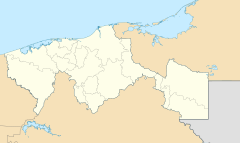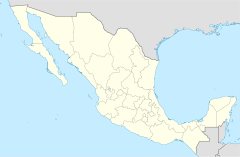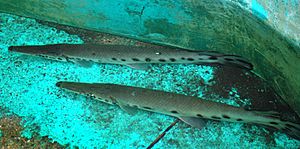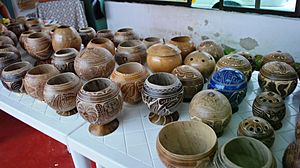Jalpa de Méndez facts for kids
Quick facts for kids
Jalpa de Méndez, Tabasco
|
|
|---|---|
| Jalpa de Méndez | |
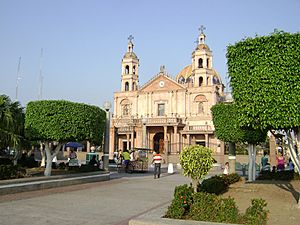
Parque Central and Parish of San Francisco of Asís
|
|
| Country | |
| State | Tabasco |
| Municipal Status | 1837 |
| Elevation
(of seat)
|
10 m (30 ft) |
| Population
(2010) Municipality
|
|
| • Municipality | 83,356 |
| Time zone | UTC-6 (Central (US Central)) |
| • Summer (DST) | UTC-5 (Central) |
| Postal code (of seat) |
86200
|
| Website | jalpademendez.gob.mx |
Jalpa de Méndez is a city in the Mexican state of Tabasco. It is located in the northern part of the state. This area is known for its Chontal Maya culture. People here traditionally make beautiful decorated dried gourds. These gourds were used for drinking chocolate and storing cured meats.
While there is some oil production and tourism, the main way people make a living is through farming. They grow crops like cacao (which is used to make chocolate), coconuts, and raise livestock.
Contents
About Jalpa de Méndez City
The city of Jalpa de Méndez is about 35 kilometers (22 miles) from Villahermosa, the state capital. Around 13,330 people live here. This settlement started as a small village a long time ago, during the Mayan period.
For many years, even during the time of Spanish rule, it has been an important center for the communities around it. Today, it is the main city for the municipality (a type of local government area) that shares its name. Most of the government offices are located here. The city's economy relies on farming, raising animals, fishing, trade, services, and tourism.
Central Park and Main Church
The heart of the city is the Parque Central, or Central Park. It is a lovely plaza with gardens full of palm, almond, and pine trees. You can also see other pretty plants there. In the middle of the park, there is a fountain shaped like a decorated gourd. This is a special symbol of the area's traditional crafts.
Next to the park is the San Francisco de Asís Church. It has been recently restored. The front of the church is built in a style called Neoclassical. It is made of sandstone and has two bell towers on each side. Inside, the church has one main open space with two sections. A dome is in the center of the roof. Look for five colorful doves inside the church. They represent the five continents. In front of the church, there is a wide open area called an atrium. It has benches, lights, and gardens. There is also a fountain that used to be a place for baptisms.
Coronel Gregorio Méndez Magaña House Museum
The Coronel Gregorio Méndez Magaña House Museum was once the home of a famous leader. He led the forces from Tabasco that won against the French in a battle called the Battle of Jahuactal. The house is made of brick with a wooden roof. Even though it has been rebuilt several times, it still looks like it did originally.
In 1984, the building became a museum. It has six rooms where you can see interesting items. These include old weapons, drawings, photographs, paintings, historical documents, and some of the coronel's personal belongings.
Casa de Cultura (Cultural Center)
The Casa de Cultura, or Cultural Center, is a building specially made for cultural activities. It was built between 1977 and 1982. Here, you can see art exhibitions, like drawings and paintings. Many other cultural events and classes happen here, especially on weekends. You can learn things like karate, guitar, piano, ballet, English, math, modern dance, and Mexican folk dance. A popular local dance is the zapateo tabasqueño. The center also has an auditorium for talks and movie showings.
Geography of Jalpa de Méndez
Most of the land in Jalpa de Méndez is flat. There are only a few small hills. The average height above sea level is about ten meters (33 feet). Several rivers form the borders of the municipality. The Nacajuca River is the border with Cunduacán. The El Naranjo River borders Nacajuca. The Cucuxchapa River forms the border with Paraíso. And the Chiquistero River borders Centla.
Lakes and Wildlife
Lakes cover a large area of 2,320 hectares (about 5,733 acres) in the municipality. Some important lakes are Pomposú, El Eslabón, La Negrita, San Agustín, El Provecho, La Tinaja, and El Troncón. Pomposú Lake is in the northern part of the municipality. Its waters have different shades of green, and palm trees grow all around it. If you go fishing here, you might catch fish like bass, mojarra, tilapia, and the unique pejelagarto.
The climate here is hot and humid. Temperatures change throughout the year. The average high temperature is about 30.5°C (87°F) in June. The coldest months are December and January, with an average temperature of 22.5°C (72.5°F). The area gets a lot of rain, about 1692mm (66 inches) per year. October is the rainiest month. The air is usually quite humid, between 75% and 86%. The windiest months are November and December. During this time, strong winds called “nortes” (because they come from the north) blow into the state from the Gulf of Mexico.
Because the land is flat and there's a lot of rain, the area can sometimes flood. There were big floods in 1999, 2007, and 2010. The 2007 flood covered most of Tabasco state.
The wildlife in Jalpa de Méndez includes animals that live on land and in water. You might see parrots, macaws, storks, manatees, and crocodiles. In the wet areas, there are still wild mangroves growing.
History of Jalpa de Méndez
The name Jalpa comes from the Nahuatl language. The phrase Shal-pan means "place over sand" or "on the edge of sand."
This area was home to many small villages during the Mayan period. The famous Spanish explorer Hernán Cortés traveled through this region on his way to what is now Honduras. Spanish families started living in the village, then called Xalpa, around 1550.
During the time of Spanish rule, the settlement became very important. It was even named the capital of the Chontalpa Region. By 1665, the town was the main government center for twelve other communities.
In 1827, the settlement of Comalcalco was created in an area that Jalpa controlled. Later, in 1834, this area became separate. This led to the creation of what are now the municipalities of Comalcalco and Paraíso. The modern municipality of Jalpa was officially created by the state government in 1837. However, the town was not named its official seat until 1852. The name "Jalpa" for the municipality was made official in 1882.
In 1887, the name was changed to Jalpa de Méndez. This was done to honor Gregorio Méndez Magaña. He was a hero who fought against the French forces between 1863 and 1864. Jalpa was officially declared a city in 1955.
Culture and Traditions
The municipality holds an annual fair at the end of May. It takes place at the Parque Club Campestre. This fair features cultural shows, commercial displays, and agricultural exhibits. Local schools and cultural centers help organize many of the events. You can also find local handcrafts, try regional foods, enjoy amusement rides, and watch folk dances. A special event is the crowning of a "Flor de Jícara" beauty queen.
Carnival is another very important annual event. It starts in January with a tradition called “quema de mal humor.” This means "burning of bad mood," and it involves burning a paper mache figure. From then until Ash Wednesday, there are dances and people wear amazing outfits, especially on Sundays. The celebrations are often accompanied by son music.
Traditional Dress and Food
Traditional clothing for women in Jalpa de Méndez includes a long, full skirt with colorful flower patterns. They wear it with a white cotton blouse that has embroidery around the collar. For men, the traditional outfit is white cotton pants and a white shirt. They also wear a red handkerchief, a special hat called a “chontal,” and carry a bag and a machete.
The local food is famous for its cured meats, like head cheese and longaniza sausage. For sweets, people enjoy treats made from sesame seeds and pine nuts. Traditional drinks include chorote, pinol, and cacaotada.
Economy and Local Industries
The main way people earn a living in Jalpa de Méndez is still through agriculture. Farmers grow basic grains, cacao, and coconuts. Raising livestock is also a big part of the local economy. This includes cattle, pigs, sheep, horses, and chickens. The many lakes in the area allow for fishing and aquaculture (fish farming), but this is not the biggest part of the economy.
Tobacco and Handcrafts
The Don Remo tobacco farm and cigar factory started in 1995. It is located in the town of Tierra Adentro. The factory is named after Remo Loaiza San Vicente, who was an important tobacco farmer. While this factory is fairly new, people have been growing tobacco here since Mayan times.
There isn't much large industry in the municipality. However, there is the Mecoacán oil field. Most manufacturing is limited to handcrafts and food processing done by small family businesses. A well-known food industry here is the making of cured meats like head cheese and longaniza sausage.
The most famous local handcraft is drying and decorating gourds. These gourds, called jícaras, were traditionally used for storage and serving food. Today, they are mostly made for tourists. The jícara was very important as a cup for drinking chocolate. Even today, it is still traditional to serve a chocolate drink called pozol in these gourds.
Commerce and Tourism
The commerce (buying and selling goods) sector has grown a lot in the last ten years. Big national chain stores like Bodega Aurrerá, Super Che, Soriana, and Parisina Telas have opened here. Services like banks, restaurants, auto shops, and pharmacies mostly serve the local people. There is one traditional municipal market called Daniel Santos Garcia in the main city.
State officials have started programs to make the area more attractive to tourists. For example, they want to make it part of the "Cacao Route." However, local officials haven't seen many results yet. Plans to create ecotourism centers, like the Chontalpa Chica, are still in the works.
The Pomposú Juliva Wetlands are located where the Mezcalpa River forms a delta. Here, you can enjoy ecotourism activities like water sports and excursions. There is also a special sanctuary for swamp crocodiles.
The Don Remo cigar factory offers tours for visitors.
The La Encantado turtle farm is special because it's the only one of its kind in Latin America. It raises six different species of turtles that are native to Tabasco. It is located in Reforma Segunda Sección and is owned by the Olán García family. In 2004, this farm won the Tabasco State Ecology Prize for its work.
See also
 In Spanish: Jalpa de Méndez para niños
In Spanish: Jalpa de Méndez para niños


